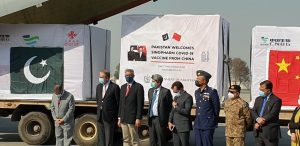Within two weeks of his inauguration, President Donald Trump announced the United States’ withdrawal from the World Health Organization and temporarily paused U.S. foreign assistance programs for review.
Based on AidData’s Global China Development Finance (GCDF) dataset, China is heading in the opposite direction of the United States, doubling down on its global health outreach program through its signature Belt and Road Initiative (BRI). During a moment of high geopolitical tension and multiple humanitarian crises in the world, retreating from global health diplomacy – an area where Washington was once the acknowledged leader – degrades the United States’ influence and reputation and undermines U.S. national security.
China is executing its effort through its Health Silk Road program, which includes projects from constructing hospitals in developing countries to providing ophthalmic operating equipment. China supported refugees in the Middle East and Asia and provided malaria and AIDS medicines to poor communities. From 2000-2014, China donated an aggregate of $1.45 billion to developing countries, but then ramped that up during the period 2015-2019, to $2.14 billion. Over the course of 20 years China sent medical teams to over 85 countries.
Despite this, the portfolio of Chinese health aid from 2000-2019 was modest. That all changed in 2020. China seized on the opportunity presented by the pandemic, with President Xi Jinping pledging $2 billion in donations to combat COVID-19 at WHO’s General Assembly in May 2020. Xi announced that, once a vaccine was developed, he would “provide 2 billion doses” to the world as a “global public good.”
According to my new research brief on China’s COVID-19 diplomacy, based on AidData’s GCDF dataset, China far exceeded these targets, doubling the amount of its original commitment. Between 2020 and 2022, China contributed more than $4.6 billion in personal protective equipment (PPE) and vaccines, surpassing traditional donors like the United States ($4.05 billion), Germany ($3.64 billion), and Japan ($2.50 billion), according to the Organization for Economic Cooperation and Development (OECD). My analysis of newly assembled data also shows that China donated over 239.1 million doses of its more costly COVID-19 vaccines and immunized 2.3 percent of the developing world’s population against the virus. While China heavily relied on its central government agencies such as China International Development Cooperation Agency (CIDCA) and Ministry of Commerce (MOFCOM), it also leveraged the provincial governments as well as its big state-owned enterprises in its COVID-19 aid program.
China intended to enhance its reputation and soft power through its COVID-19 diplomacy. AidData researchers have previously analyzed how China provides large amounts of aid and credit to low- and middle-income countries (LMICs) that are soft power battlegrounds between itself and the United States. Their analysis demonstrates that China does not focus on “moonshot countries” where it will likely be difficult for China to sway national public sentiment; instead it focuses on “toss-up” countries. Consistent with this finding, my analysis shows that 13 of the top 20 recipients of Chinese COVID-19 aid, such as Nepal, the Philippines, and Indonesia, are “toss-up” countries, subject to an influence and opinion tug-of-war, where China could potentially sway public and elite opinion through acts of goodwill.
While China makes inroads in public health diplomacy, the United States is abandoning its status as the most generous provider of health aid. During the pandemic, the United States officially pledged 1.1 billion doses of COVID-19 vaccines and delivered over 672 million doses and other medical equipment by the end of 2022. The U.S., unlike China, preferred cooperating and channeling aid through multilateral agencies such as the WHO. While the U.S. primarily relied on the COVAX initiative to distribute its vaccines, China channeled only about 3 percent of its total donation – 7.34 million doses – through the COVAX initiative, choosing instead to deliver the majority of its aid bilaterally through official government agreements. China seems to prefer bilateral programs because they are faster and have fewer restraints.
Withdrawing from the WHO will leave a huge vacuum that cannot be filled in the short term. The United States has been the largest contributor to the WHO: It far outspends China in both the assessed contribution (each member-state’s obligatory contribution based on wealth) and voluntary contribution (optional spending designed for specific programs). In 2024, for example, while the United States contributed around $700 million in voluntary contributions, China’s contribution was less than $30 million, representing 0.6 percent of total voluntary contributions. As a result of the U.S. withdrawal, there will be fewer funds to treat infectious diseases and provide medical support to vulnerable communities such as Rohingya refugees in Myanmar.
While it is unlikely China will entirely fill the void left by the United States, China’s expanding role in global health and its massive COVID-19 aid program demonstrate that China will likely replace the United States as the global leader in public health. In a future health crisis, China is well-positioned to assume a leadership position and utilize its advanced supply chains to provide medical aid more generously than competitors.
Reducing foreign aid for public health initiatives not only undermines U.S. commitment to the international community but also opens space for competitors.
If the pandemic taught us anything, it is that overseas health crises do not respect borders. Global health issues far overseas have the potential to affect the health of every American, and is an economic and national security issue as well. For these reasons as well as the reputational advantages gained, the United States should continue to support vulnerable populations globally through public health programs delivered bilaterally. It is in the country’s national interest to do so. When the world is healthy, America prospers too.

































